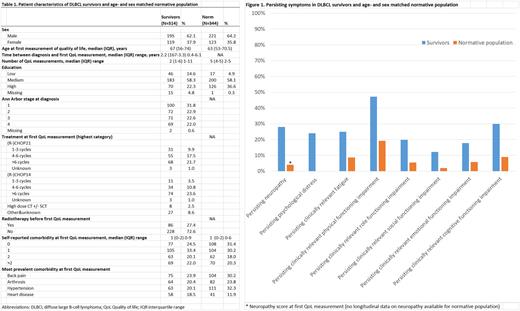Abstract
Introduction Since the addition of rituximab to CHOP chemotherapy regimen in the early 2000s, 5-year overall survival of diffuse large B-cell lymphoma (DLBCL) increased from around 45% to 65%. R-CHOP21 is preferred over R-CHOP14 as survival rates are similar, toxicity is lower and health-related quality of life (HRQoL) is higher (Cunningham et al 2013; Issa et al, 2021, Oerlemans 2014). Little is known about the course of (long-term) symptoms and their impact on HRQoL over time, especially among patients treated outside randomized clinical trials. Our aim was to investigate the course of fatigue, neuropathy, psychological distress in a population-based cohort of survivors of DLBCL up to 8 years after treatment and to compare scores to those of an age- and sex-matched normative population without cancer. Furthermore, age, sex, treatment and comorbidity related differences were studied to better identify those at risk for unfavorable HRQoL outcomes.
Methods Patients with DLBCL diagnosed between 2004-2011, who survived at least 1 year were selected from the population-based Netherlands Cancer Registry (NCR) in 11 hospital locations of the Southern part of the Netherlands. They were invited to participate between 2009 and 2012, and to complete the EORTC QLQ-C30, CLL-16 and the Hospital Anxiety and Depression Scale (HADS) questionnaires annually until 2015. Sociodemographic data were obtained from the NCR, supplemented with detailed clinical information from the PHAROS registry. Clinically important symptoms and functional health impairments were defined by thresholds of clinical importance (TCI), as developed for the EORTC QLQ-C30 (Giesinger et al., 2020). We defined symptoms as persistent for patients who completed ≥2 measurements and had more than half of their measurements fulfilling the TCI. Growth modeling was performed to evaluate the course of fatigue, neuropathy and psychological distress. With linear mixed models, relevant sociodemographic and clinical factors associated with the course of symptoms over time were assessed, and the association between the presence of symptoms and HRQoL was evaluated.
Results Response rate at the first measurement was 84% and patients completed a median of 2 questionnaires (Interquartile range (IQR) 1-6). The cohort consisted of 195 men (62%) and 119 women (38%) and the first HRQoL measurement was performed at a median of 2.2 years (IQR 1.6-3.3) after diagnosis, when they were aged 67 years (IQR 56-74). Almost all patients were treated with (immuno-)chemotherapy before their first HRQoL measurement, mostly (R-)CHOP21 (50%) or (R-)CHOP14 (39%), and/or radiotherapy in 27% of patients (Table 1). Persisting neuropathy was reported by 28% of patients, persisting fatigue by 25% and persisting psychological distress by 24%. The level of fatigue, neuropathy and psychological distress remained stable over time. Over time, Ann Arbor stage IV compared to Ann Arbor stage I, and >2 comorbidities compared to no comorbidities were significantly associated with higher levels of fatigue. For neuropathy, higher age at questionnaire completion, >2 comorbidities and >6 cycles of (R-)CHOP14 compared to ≤6 cycles of R-CHOP21 were significantly associated with worse outcomes; a higher educational level was associated with better outcomes. For psychological distress, Ann Arbor stage IV and >2 comorbidities were significantly associated with more distress, whereas patients with a higher education reported less distress. Furthermore, 12-47% of patients reported clinically important functional health impairments (Figure 1). Compared to the normative population, this was 3-6 times more. Higher levels of fatigue, neuropathy or psychological distress, as well as female sex and having >2 comorbidities were associated with a lower HRQoL sum score.
Conclusion This population-based study describes a real-world setting with patients followed up until 8 years after diagnosis. Fatigue, neuropathy and psychological distress are persisting symptoms in about one in four DLBCL survivors, negatively impacting their HRQoL. Along with other factors, treatment with >6 cycles of R-CHOP14 was significantly associated with higher levels of neuropathy and levels did not improve over time. Attention of factors associated with unfavorable HRQoL outcomes and early recognition of symptoms will help in providing patient-tailored supportive care for those in need.
Disclosures
Kersten:Adicet Bio: Honoraria; Novartis: Honoraria; Roche: Honoraria, Research Funding; Takeda: Honoraria; BMS/Celgene: Honoraria, Research Funding; Miltenyi Biotech: Honoraria; Kite, a Gilead Company: Honoraria, Research Funding.
Author notes
Asterisk with author names denotes non-ASH members.


This feature is available to Subscribers Only
Sign In or Create an Account Close Modal